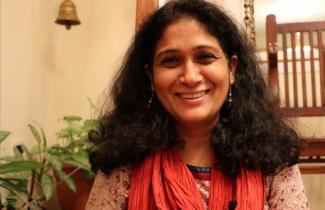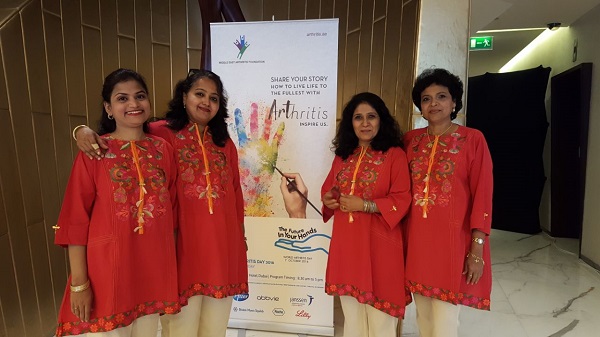
Vonita Singh, who conducts therapeutic dance classes Movement Mantra in Dubai, is herself a patient of Rheumatoid Arthritis from a very early age. She shares how she fought to overcome the physical challenges
Tell us a little about when RA started? What were the symptoms?
It all started with the big toe of my right foot - I was all of 18 years old! Subtle pain and tenderness were the main symptoms initially, but that did not create enough anxiety for me to talk about it with anyone, including mum. I tried to manage most of the times, up until one day when I had to walk back bare foot from a family gathering, shoes in my hand! The pain was unbearable. Initially it was thought to be gout and doctors recommended tests for the same. Results were negative and so was my RF (Rheumatoid Factor) test. I must have been 20 years old when it was formally diagnosed to be sero–ve (sero negative) Rheumatoid Arthritis!.
Does the condition run in your family?
Yes it is in the family. My mother had this condition and she had inherited it from her mother! It doesn’t stop here – the genes have travelled to our older daughter.
Do you have chronic pain? Or flare ups? Please tell us how you managed to cope with it.
My pain for the last 8-9 years has been a bit quiet – I owe a lot of that to minor changes in my lifestyle. The initial years after the diagnosis were rather uphill and I became dependent for many of my daily chores on friends and family.
How much did it affect your lifestyle and normal activities that every teenager is used to?
I have always been an outdoor and physically active person. I played sports at school, dance classes five days a week, cycled on weekends. My biggest concern was that I may have to stop all of this as in a few years post diagnosis, my knees and ankles had also started to experience inflammation and pain. There were times that I would not let mom know about my pain lest she cancel my dance lesson! Having said that, I had to reduce my level of physical involvement but not stop it completely.
Did you take medications?
Absolutely! There were no steroids and the likes of Methotrexate at that time, but I kept pain and inflammation at bay with non steroidal anti inflammatory drugs (NSAIDs). I consumed so many of these pills to stay okay that I landed up with peptic ulcers!
Did your condition improve as you grew older?
By the time I was in my thirties, my small finger joints and wrists also got affected . My back had a couple of bad flare ups too. After my first delivery, I was quite sore and dependent. But when I reached my forties, I felt that the condition was less challenging and consumption of pain killers had come down too. I have just struck my half century a few months back and very happy to share that I am pretty much without any medication.
You have been a trained dancer. How did you continue dancing despite your difficulties?
I started learning Kathak (an Indian classical dance) when I was four years old. When the big toe pain started, my aunt told my mum to stop my dance classes as she attributed the pain to my excessive footwork, which is one of the main features of this dance style. Worried that it may just happen, I stopped complaining about my pain to my mother. I still remember the meeting with my orthopaedic in Delhi, whose words were like music to my ears. He told me to continue with dance, move subtly and listen to my body. “Move every joint, do all the chores at home too but do not exert”, he said. This helped erase whatever doubts I had about the positive co-relation between my dance and managing my RA condition –I have never let go of dance ever since.
Download: Tips on Making Cooking Easier when you have Arthritis

Did you take recourse to any alternative medicine to help alleviate your distress?
I think I speak for many of us in similar situations when I say, “Yes”! I tried all possible alternate medications and interventions, be it Ayurveda, Homeopathy, Acupressure or Acupuncture. I took homeopathy for the longest time in combination with my NSAIDs. All of these treatments have had some positive effect but none is a cure in itself.
How do you keep upbeat while coping with your pain?
The strength to cope with the pain comes with complete acceptance of the condition. It wasn’t easy for me, for example, to ask someone to open my small bottle of water as my hands and wrists failed me to undo the cap! During the college hostel stint, my roommate would have to help me get into my bottoms and shoes as I could not bend down. That did dampen my spirits .Over the years, it’s been victory of mind over matter. Dance which started as a childhood hobby, continued for decades as an activity which I enjoyed and now in the last few years, dance and yoga have become the most beautiful tools of intervention.
Please tell us how your daughter also faced the same problem in her early years?
This is an evolving story of our lives. Our daughter’s symptoms started when she was 15 years old. The first few times that she complained about pain in her knees, elbows and thumb, we attributed it to just some pains, especially as she had started playing tennis and volleyball. It was déjá-vu for me as she pretty much had the same experiences that I had gone through with my big toe! Whilst none of this was pleasant, I felt we coped better through this time because of our shared connection! In our daughter’s case, we tried to manage with painkillers and alternate medication for some time before submitting to Methotrexate and Biologics.
What is your advice to people who suffer from this condition early in their lives?
Like in any disease or medical condition, it is of utmost importance to get the problem diagnosed. Next step then is to educate oneself on the topic and become aware because with acceptance and awareness comes conviction and the belief in the treatment. Do not delay the treatment!!!
Rheumatoid Arthritis is a chronic condition, so best is to give ourselves short term targets, achievable targets ensuring quality of life with maximum functionality. To constantly look for answers to questions such as: "When will I get cured?" Or "Do I have to take medicines for the rest of my life?" will only lead to frustration and anxiety as science does not have definite answers (yet) for this auto immune disorder.
I have found tremendous relief by maintaining a regular exercise regime, eating sensibly (food type affects each patient’s body differently so take some time to acquaint yourself with this) and remaining positive. My conviction in mindful movement has exponentially grown since incorporating Movement Mantra and seeing significantly positive changes in people with mobility challenges caused for instance by Rheumatoid Arthritis and Parkinson’s Disease.
Download our popular 20 Tips to Manage Arthritis ebook in English
Download our new 20 Tips to Manage Arthritis ebook in Hindi






